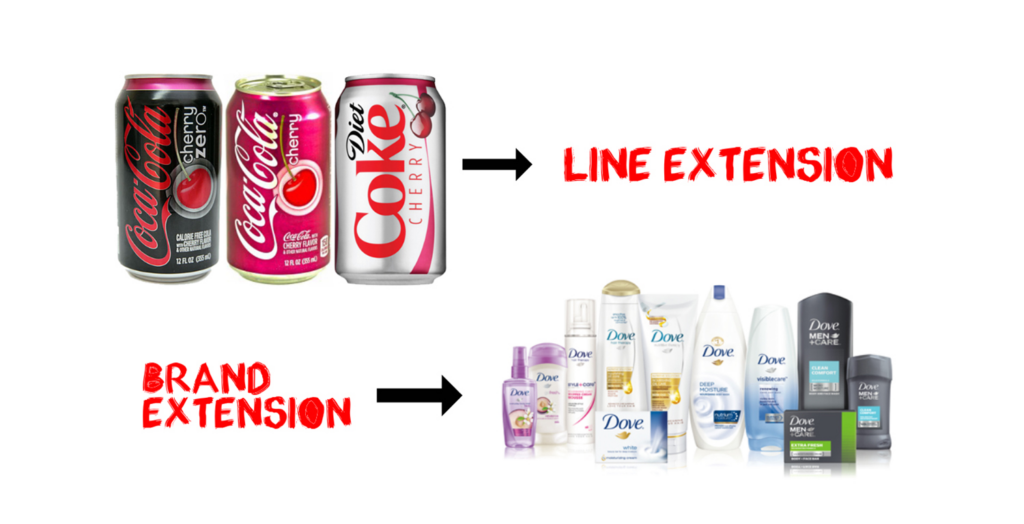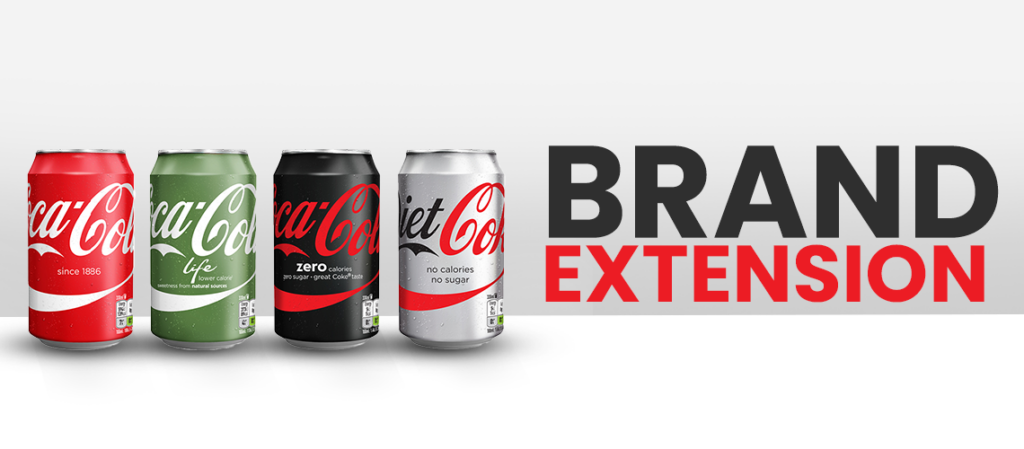Expanding your brand comes with its own set of challenges and questions, like which strategy to choose – a brand extension or line extension? Studies reveal that the right choice between these two can significantly impact a company’s success.
This article will help you navigate through this crucial decision by highlighting the benefits, risks, and real-world examples of each strategy. Ready to boost your business growth? Let’s dive in!
Key Takeaways
- Line extension involves introducing new products within an existing product line, while brand extension uses an established brand to enter a different product category.
- Benefits of line extension include meeting customer needs, increasing market share, and cost efficiencies.
- Risks of line extension include brand dilution, cannibalization of existing products, and damage to the brand’s reputation if the new products fail to meet expectations.
- Brand extension allows companies to leverage their existing brand reputation, target different segments within their customer base, and save on costs by utilizing existing distribution channels. However, it also carries risks such as brand dilution and not aligning with the core values of the original brand.
Line Extension vs Brand Extension
Line extension refers to the process of introducing new products within an existing product line, while brand extension involves using an established brand name to enter a completely different product category.
Definition and explanation of line extension
Line extension refers to the process where a company introduces additional items in a given product category under the same brand name. This strategy serves to meet different customer needs within the same product category with slight variations such as flavor, size, or color.
For example, a beverage company may launch various flavors of its popular drink under the same brand name – this is line extension. It leverages on an existing strong brand reputation to increase sales and market share within that specific product range without having to introduce an entirely new brand.
Definition and explanation of brand extension
Brand extension is a strategy where a company uses its existing brand name to introduce new products or enter into different product categories. It involves leveraging the strong reputation and customer loyalty associated with an established brand to expand into related markets.
For example, Nike started as a athletic shoe brand but has successfully extended its brand into apparel, accessories, and even technology products like fitness trackers.
The goal of brand extension is to capitalize on the trust and recognition that consumers have for the original brand, increasing the chances of success for the new offerings. By using their existing brand equity, companies can save on marketing costs and benefit from instant recognition in the marketplace.

Benefits and Risks of Extending a Brand
Line extension offers several benefits, including the ability to leverage existing brand equity and consumer loyalty, increased market share within a specific product category, cost efficiencies in marketing and production, and the opportunity for incremental sales growth.
However, there are also risks associated with line extension such as cannibalization of existing products, dilution of brand identity, confusion among consumers about product positioning, and potential damage to overall brand image if the line extension fails to meet customer expectations.
On the other hand, brand extension allows companies to enter new markets or product categories while benefiting from their strong brand reputation. This strategy can lead to increased consumer awareness and preference as well as opportunities for cross-selling and upselling.
However, brand extension also carries risks such as potential damage to the original brand’s image if the new offering is not successful or does not align with consumer perceptions of the brand.
Benefits of line extension
Line extension offers several benefits for a brand. First, it allows the brand to capitalize on its existing consumer base by introducing new products within the same product category.
This helps to meet the evolving needs and preferences of customers, ultimately fostering loyalty and repeat purchases. Second, line extension can help increase market share by providing more options for consumers to choose from within a specific product line.
This can be particularly effective in highly competitive industries where differentiation is crucial. Lastly, line extension enables cost savings through economies of scale as manufacturing processes are already established for the parent brand.
Risks of line extension
Expanding a product line within the same category can be risky for a brand. One of the main risks is brand dilution, where customers may perceive the extended products as lower in quality or less authentic compared to the original ones.
This can lead to a loss of trust and loyalty from consumers. Another risk is cannibalization, where new products steal sales and market share from existing ones instead of attracting new customers.
Additionally, if the line extension fails to meet customer expectations or doesn’t resonate with their needs, it can damage the brand’s reputation and erode its equity. Hence, careful consideration and market research are necessary before embarking on a line extension strategy to mitigate these risks and ensure long-term success.

Benefits of brand extension
Brand extension offers several advantages for companies. First, it allows them to leverage the existing brand equity and recognition they have built with their core product or service.
By extending into new categories or markets, they can capitalize on the trust and loyalty consumers already have towards their brand.
Secondly, brand extension enables companies to target different segments within their existing customer base. This strategy helps them reach a wider audience and increase market share without having to invest in creating an entirely new brand from scratch.
Additionally, brand extension can lead to cost savings by utilizing existing distribution channels and supply chains. Companies don’t have to start from scratch when it comes to establishing relationships with retailers or manufacturing partners.
Risks of brand extension
Brand extension can be an effective strategy to expand a company’s product offerings and reach new markets. However, there are also risks involved in this approach. One of the main risks is brand dilution, where the brand’s image or reputation may become weakened or compromised when associated with too many different products.
This can lead to confusion among consumers and a loss of trust in the brand. Another risk is that the new product may not align with the core values and identity of the original brand, which can result in a disconnect with existing customers.
Additionally, if the new product fails or underperforms, it can have a negative impact on the overall perception of the brand. Therefore, careful consideration should be given to ensure that any brand extension aligns with the company’s overall strategy and maintains consistency with its existing products and customer base.
Examples of Line Extension and Brand Extension
Explore successful and failed line extensions and brand extensions to understand the impact of these strategies on consumer perception and brand equity.
Examples of successful line extensions
Successful line extensions occur when a brand introduces new products within the same product category. For instance, Coca-Cola’s introduction of Diet Coke and Cherry Coke are successful line extensions that cater to different consumer preferences within the soda market.
Similarly, in the beauty industry, Maybelline’s expansion into mascara variants such as volumizing, lengthening, and waterproof options has been a hit among consumers looking for specific lash-enhancing solutions.
These examples highlight how line extensions can effectively meet diverse customer needs and expand a brand’s presence in their target market.
Examples of successful brand extensions
McDonald’s is a great example of successful brand extensions. While they are primarily known for their fast food, they have successfully extended their brand into other areas. One such extension is the introduction of McCafé, which offers a range of coffee and related products.
This move allowed McDonald’s to tap into the lucrative coffee market and appeal to customers who may not necessarily be interested in their regular menu items. Another successful brand extension from McDonald’s is their Happy Meal toys, which have become iconic and synonymous with the brand.
By offering toys with their kids’ meals, McDonald’s has created a unique selling proposition that sets them apart from competitors in the industry.
Another example of a successful brand extension is Tropicana’s expansion into fruit snacks. Known for its orange juice, Tropicana leveraged its strong reputation as a trusted source of fruit-based products to enter the snack category successfully.
By introducing fruit snacks made with real fruit juice, Tropicana was able to cater to health-conscious consumers looking for convenient yet wholesome snack options.

Examples of failed line extensions
Several brands have made the mistake of launching failed line extensions, where they introduced new products within the same product category that ultimately did not resonate with consumers.
For example, a popular soda brand attempted to extend their line by introducing a new flavor that was completely different from their original offerings. However, this new flavor did not align with the brand’s identity and ended up confusing customers rather than attracting them.
Another example is a well-known beauty company that tried to expand its product line into haircare but failed due to poor quality and lackluster marketing efforts. These examples highlight the importance of thoroughly understanding consumer preferences and ensuring that any line extension stays true to the core values and reputation of the brand.
Examples of failed brand extensions
Many companies have attempted brand extensions, only to see them fail miserably. One example is Coca-Cola’s foray into the world of clothing with their “Coke Clothing” line. Despite its initial hype and popularity, the clothing line ultimately did not resonate with consumers and was discontinued after a short period of time.
Another failed brand extension is Harley-Davidson’s attempt to launch a line of perfumes for women. This move was met with backlash from loyal customers who felt that it deviated too much from the company’s rugged and masculine image.
Both examples serve as cautionary tales about the importance of maintaining brand consistency and understanding consumer perceptions when considering a brand extension strategy.
When to Choose Line Extension vs Brand Extension
Consider factors such as consumer research, brand identity alignment, and market expansion possibilities when deciding between line extension or brand extension strategies.
Factors to consider
Factors to consider when deciding between line extension and brand extension include the product category, target market, and brand equity. The product category plays a crucial role in determining whether a line extension or brand extension is more suitable.
Line extensions are best suited for existing products within the same category, while brand extensions allow for expansion into new categories. Additionally, understanding the preferences of the target market is important as it can help determine which strategy would resonate better with consumers.
Finally, considering the strength of your brand’s equity is essential because brand extensions rely on leveraging existing consumer perceptions and associations.
How to decide which strategy to use
To determine whether to use a brand extension or a line extension strategy, several factors need consideration. Firstly, it is crucial to assess the current market conditions and competition within the industry.
Conducting thorough consumer research is essential in understanding consumer preferences and needs. It is also important to align any extension strategy with the existing brand identity and maintain consistency in terms of values, imagery, and messaging.
By carefully considering these factors, businesses can make informed decisions on which extension strategy to pursue for maximum impact and success.
Importance of consumer research
Understanding the importance of consumer research is crucial when deciding between line extension and brand extension strategies. Consumer research helps companies gain valuable insights into their target market’s preferences, needs, and expectations.
By conducting thorough research, businesses can identify potential opportunities for product expansion and assess the level of acceptance or demand for a new offering. This information allows companies to make informed decisions about whether to pursue line extensions or brand extensions based on consumer preferences, ensuring that they meet the evolving needs of their customers while minimizing risks associated with introducing new products.
Importance of aligning with brand identity
Aligning with brand identity is crucial when extending a brand. It ensures that the new products or services introduced under the brand maintain consistency and resonate with consumers.
When a brand extends into new territories, it must stay true to its core values, positioning, and image to build trust and loyalty among customers. By aligning with the brand’s identity, extension efforts can leverage the existing equity of the brand and strengthen its overall impact in the market.
Failing to align with the brand identity can risk diluting customer perception and damaging the reputation of both the extended products/services and the parent brand itself.
Conclusion: Choosing the right extension strategy
Choosing the right extension strategy is crucial for the success of a brand. It requires careful consideration of various factors, such as market conditions, consumer preferences, and brand identity.
One important factor to consider is whether to pursue a line extension or a brand extension. Line extensions involve introducing new products within an existing product category, while brand extensions involve expanding into new product categories.
To decide which strategy to use, it’s important to conduct thorough consumer research. This helps in understanding the target audience’s needs and preferences and identifying potential opportunities for growth.
Additionally, brands should align their chosen extension strategy with their overall brand identity and values.
It’s also important to recognize that both strategies come with advantages and risks. Line extensions can capitalize on existing brand equity and customer loyalty but may face challenges in standing out among competitors.
On the other hand, brand extensions offer opportunities for diversification but run the risk of diluting the core brand image.
Frequently Asked Questions
1. What is the difference between brand extension and line extension?
Brand extension involves entering a new product category under the existing brand name, while line extension refers to adding new products under an already established product line.
2. Why might food industry companies choose line extensions over brand extensions?
In the food industry, companies often choose line extensions as they are safer plays that involve less risk compared to stretching brands into new categories while developing a diversified product portfolio.
3. How does brand diversification relate to brand versus line extensions?
Brand diversification often implies utilizing a winning strategy of both types; using an existing famous name for creating a successful brand expansion in one segment and employing small experiments with different variations in another area resulting in effective product line expansion.
4. Can a company use both brand and line extension strategies simultaneously?
Yes, businesses can mix their strategies by applying both techniques – stretching their brands within the same category or expanding into new markets with entirely different offerings aiming at market segmentation or targeting various customer groups.
5. Which strategy carries more potential disadvantages, Brand Extension or Line Extension?
Both methods come with risks; too much exposure could dilute the original branding (brand stretching), whereas excessive modifications may confuse customers leading to losses(product diversification). It’s essential that any changes align well with overall Brand Management goals.




